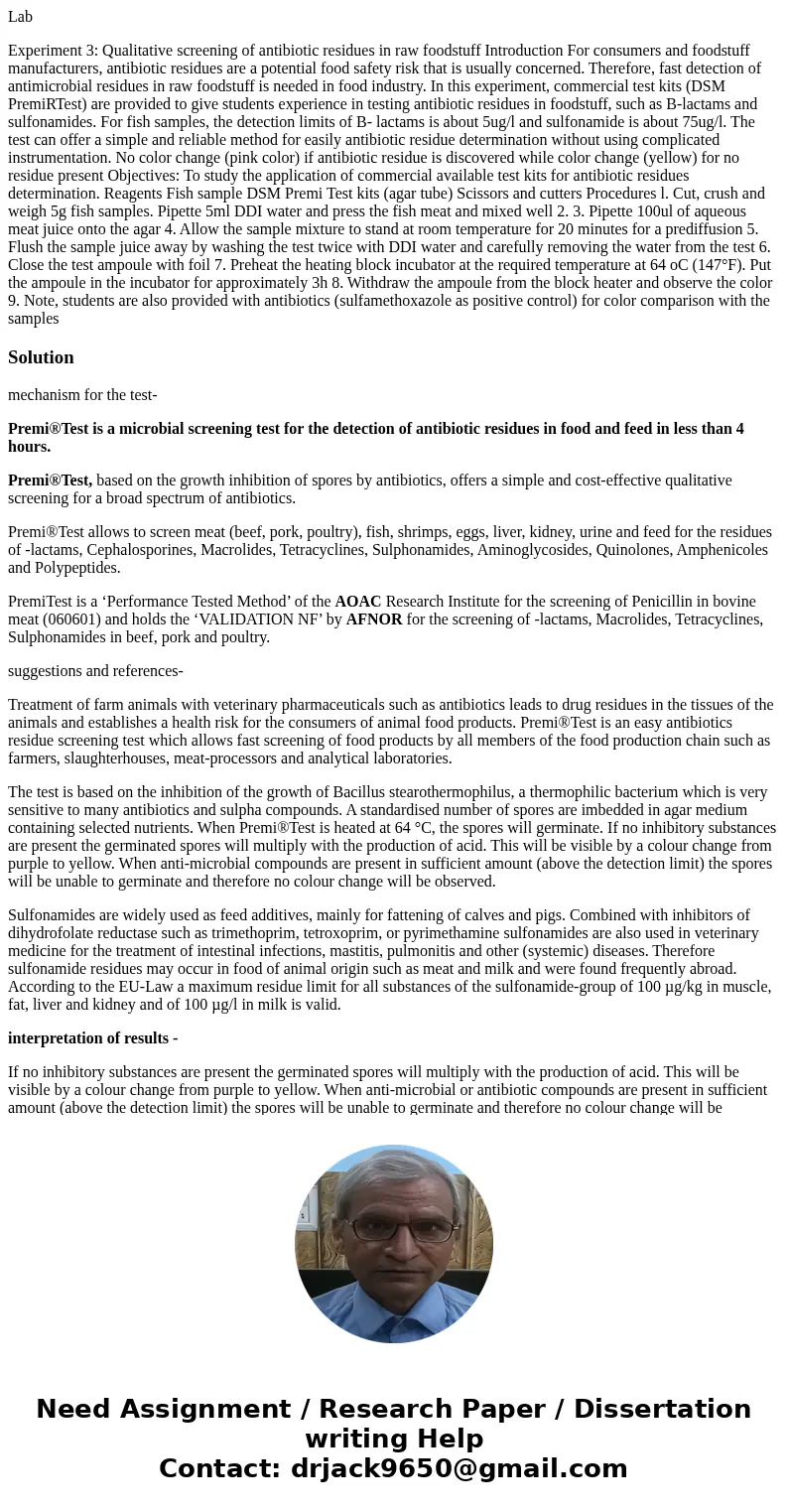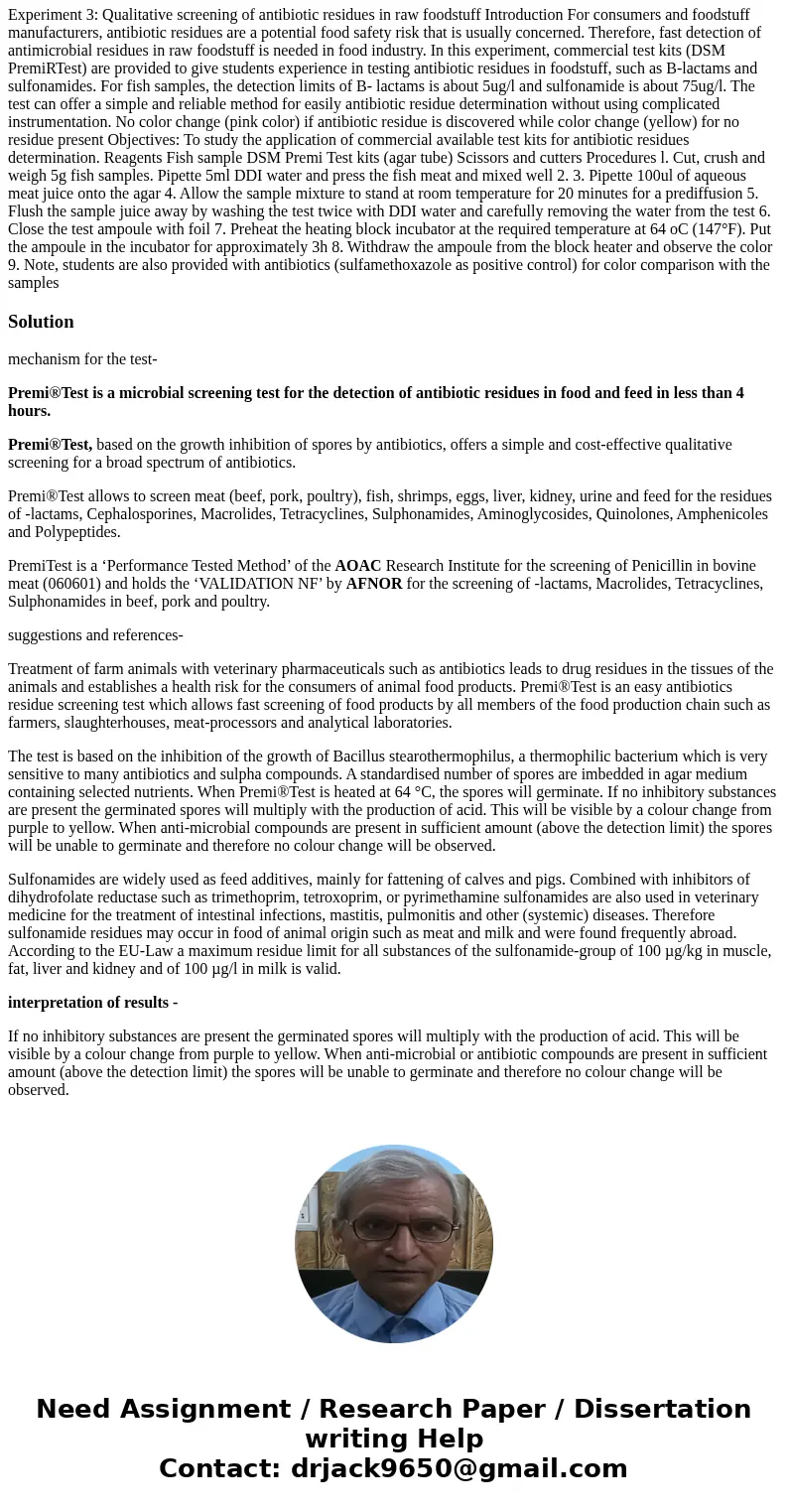Lab Experiment 3 Qualitative screening of antibiotic residue
Lab
Experiment 3: Qualitative screening of antibiotic residues in raw foodstuff Introduction For consumers and foodstuff manufacturers, antibiotic residues are a potential food safety risk that is usually concerned. Therefore, fast detection of antimicrobial residues in raw foodstuff is needed in food industry. In this experiment, commercial test kits (DSM PremiRTest) are provided to give students experience in testing antibiotic residues in foodstuff, such as B-lactams and sulfonamides. For fish samples, the detection limits of B- lactams is about 5ug/l and sulfonamide is about 75ug/l. The test can offer a simple and reliable method for easily antibiotic residue determination without using complicated instrumentation. No color change (pink color) if antibiotic residue is discovered while color change (yellow) for no residue present Objectives: To study the application of commercial available test kits for antibiotic residues determination. Reagents Fish sample DSM Premi Test kits (agar tube) Scissors and cutters Procedures l. Cut, crush and weigh 5g fish samples. Pipette 5ml DDI water and press the fish meat and mixed well 2. 3. Pipette 100ul of aqueous meat juice onto the agar 4. Allow the sample mixture to stand at room temperature for 20 minutes for a prediffusion 5. Flush the sample juice away by washing the test twice with DDI water and carefully removing the water from the test 6. Close the test ampoule with foil 7. Preheat the heating block incubator at the required temperature at 64 oC (147°F). Put the ampoule in the incubator for approximately 3h 8. Withdraw the ampoule from the block heater and observe the color 9. Note, students are also provided with antibiotics (sulfamethoxazole as positive control) for color comparison with the samplesSolution
mechanism for the test-
Premi®Test is a microbial screening test for the detection of antibiotic residues in food and feed in less than 4 hours.
Premi®Test, based on the growth inhibition of spores by antibiotics, offers a simple and cost-effective qualitative screening for a broad spectrum of antibiotics.
Premi®Test allows to screen meat (beef, pork, poultry), fish, shrimps, eggs, liver, kidney, urine and feed for the residues of -lactams, Cephalosporines, Macrolides, Tetracyclines, Sulphonamides, Aminoglycosides, Quinolones, Amphenicoles and Polypeptides.
PremiTest is a ‘Performance Tested Method’ of the AOAC Research Institute for the screening of Penicillin in bovine meat (060601) and holds the ‘VALIDATION NF’ by AFNOR for the screening of -lactams, Macrolides, Tetracyclines, Sulphonamides in beef, pork and poultry.
suggestions and references-
Treatment of farm animals with veterinary pharmaceuticals such as antibiotics leads to drug residues in the tissues of the animals and establishes a health risk for the consumers of animal food products. Premi®Test is an easy antibiotics residue screening test which allows fast screening of food products by all members of the food production chain such as farmers, slaughterhouses, meat-processors and analytical laboratories.
The test is based on the inhibition of the growth of Bacillus stearothermophilus, a thermophilic bacterium which is very sensitive to many antibiotics and sulpha compounds. A standardised number of spores are imbedded in agar medium containing selected nutrients. When Premi®Test is heated at 64 °C, the spores will germinate. If no inhibitory substances are present the germinated spores will multiply with the production of acid. This will be visible by a colour change from purple to yellow. When anti-microbial compounds are present in sufficient amount (above the detection limit) the spores will be unable to germinate and therefore no colour change will be observed.
Sulfonamides are widely used as feed additives, mainly for fattening of calves and pigs. Combined with inhibitors of dihydrofolate reductase such as trimethoprim, tetroxoprim, or pyrimethamine sulfonamides are also used in veterinary medicine for the treatment of intestinal infections, mastitis, pulmonitis and other (systemic) diseases. Therefore sulfonamide residues may occur in food of animal origin such as meat and milk and were found frequently abroad. According to the EU-Law a maximum residue limit for all substances of the sulfonamide-group of 100 µg/kg in muscle, fat, liver and kidney and of 100 µg/l in milk is valid.
interpretation of results -
If no inhibitory substances are present the germinated spores will multiply with the production of acid. This will be visible by a colour change from purple to yellow. When anti-microbial or antibiotic compounds are present in sufficient amount (above the detection limit) the spores will be unable to germinate and therefore no colour change will be observed.


 Homework Sourse
Homework Sourse